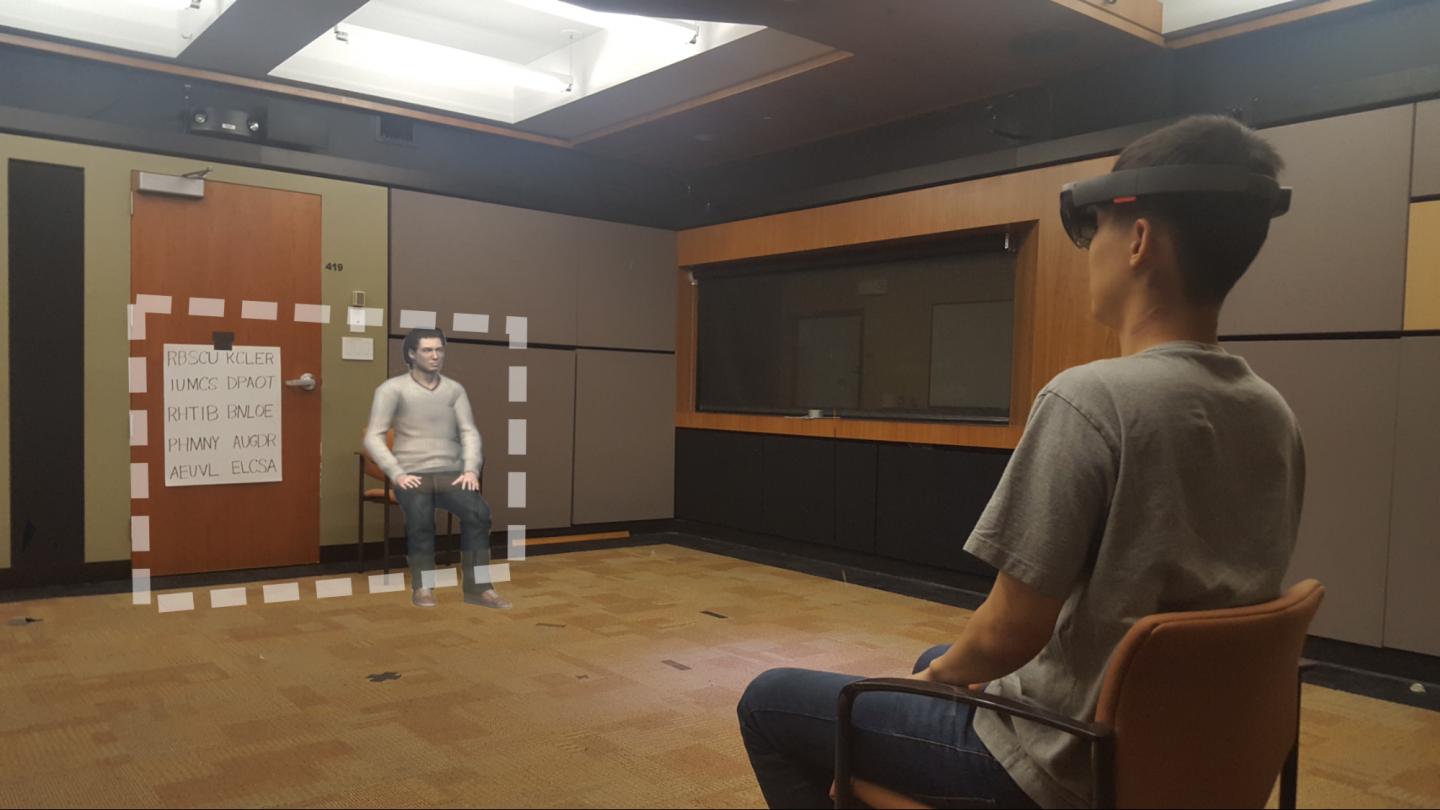
Credit: Mark Miller and Stanford’s Virtual Human Interaction Lab
As major technology firms race to roll out augmented reality products, Stanford researchers are learning how it affects people’s behavior – in both the physical world and a digitally enhanced one.
In a new study led by Jeremy Bailenson, a professor of communication in the School of Humanities and Sciences, researchers found that after people had an experience in augmented reality (AR) – simulated by wearing goggles that layer computer-generated content onto real-world environments – their interactions in their physical world changed as well, even with the AR device removed. For example, people avoided sitting on a chair they had just seen a virtual person sit on. Researchers also found that participants appeared to be influenced by the presence of a virtual person in a similar way they would be if a real person were next to them. These findings are set to publish May 14 in PLOS ONE.
“We’ve discovered that using augmented reality technology can change where you walk, how you turn your head, how well you do on tasks, and how you connect socially with other physical people in the room,” said Bailenson, who co-authored the paper with graduate students Mark Roman Miller, Hanseul Jun and Fernanda Herrera, who are the lead authors.
Their findings mirror much of the research Bailenson has done on virtual reality (VR). While VR attempts to simulate a real-life environment and take the user out of the present setting, AR technology layers digital information atop the user’s physical surroundings.
In recent years, many technology companies have focused on developing augmented reality goggles and other products, shifting away from their previous emphasis on virtual reality, Bailenson said.
Bailenson said today’s AR goggles can project a realistic, 3D version of an actual person in real time onto the physical surroundings of the goggles-wearer. This allows for groups of people across the world to make eye contact and communicate nonverbally in other nuanced ways – something that video conferencing struggles to achieve.
“AR could help the climate change crisis by allowing realistic virtual meetings, which would avoid the need for gas to commute or flying to meetings in person,” Bailenson said. “And this research can help bring attention to the possible social consequences of AR use at a large scale, so the technology can be designed to avoid these issues before becoming ubiquitous.”
Researching AR effects
To examine how AR affected the way people behaved in social situations, researchers recruited 218 participants and conducted three studies. In the first two experiments, each participant interacted with a virtual avatar named Chris who would sit on a real chair in front of them.
The first study replicated a traditional psychology finding known as social inhibition. Just as people complete easy tasks with ease and struggle with more challenging ones when they have a person watching them in the real world, the same held true when an avatar was watching study participants in augmented reality, the researchers found.
Study participants completed easy anagrams faster but performed poorly on the complex ones when avatar Chris was visible in their AR field of vision.
Another study tested whether participants would follow accepted social cues when interacting with avatar Chris. This was measured by tracking whether participants would sit on the chair that avatar Chris previously sat on.
Researchers found that all participants who wore the AR headset sat on the empty chair next to Chris instead of sitting right on the avatar. Of those participants who were asked to take off the headset before choosing their seat, 72 percent still chose to sit in the empty chair next to where Chris sat previously.
Social connections affected
“The fact that not a single one of the subjects with headsets took the seat where the avatar sat was a bit of a surprise,” Bailenson said. “These results highlight how AR content integrates with your physical space, affecting the way you interact with it. The presence of AR content also appears to linger after the goggles are taken off.”
In the third study, researchers examined how AR affects the social connection between two people who are having a conversation while one of them wears an AR headset. Researchers found that those wearing AR goggles reported feeling less socially connected to their conversation partner.
Bailenson said that additional studies, which he and his team are now working on, are needed to further examine the effects of augmented reality.
“This paper scratches the surface of the social-psychological costs and benefits of AR use, but much research is needed to understand the effects of this technology as it scales,” the researchers wrote.
###
This research was supported by two National Science Foundation grants.
Media Contact
Alexandra Shashkevich
[email protected]
Original Source
https:/
Related Journal Article
http://dx.



